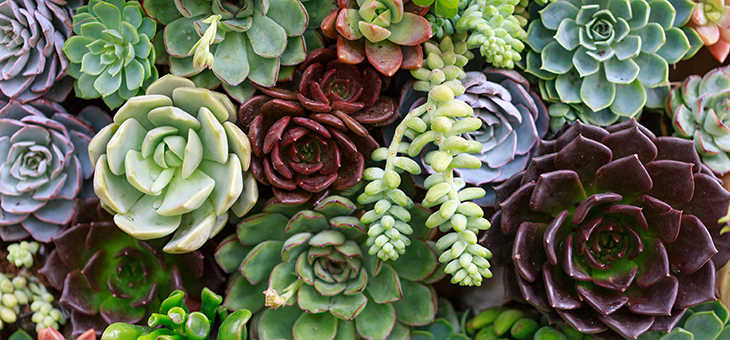If you have a sunny, sheltered spot and some protection from rain, you should be able to create a potted display of succulents that will provide year-round interest.
What plants are suitable?
You can use a selection to provide colour and form, including sedum, of which there are many colours, from cream-hued types such as Sedum oregonense to the purple Sedum spathulifolium ‘Purpureum’. Mixed with sempervivums (houseleeks), which have a wider rosette form, they will create an eye-catching display.
As mat-forming sempervivums mature, they produce spikes of star-shaped white, yellow, pink or red flowers which, when they die off, are replaced by new rosettes around the edge. In winter, the leaves darken on some varieties including Sempervivum ‘Engle’s’.
Sempervivum calcareum is very hardy but still requires good drainage, according to the Eden Project. It also lists Crassula muscosa, Sedum morganianum (an ideal trailing variety) and Aeonium ‘Cyclops’ among its top succulents.
Other dramatic additions include the cobweb houseleek, Sempervivum arachnoideum, which bears pale green rosettes covered with fine webbing, like cobwebs. In early summer it bears small pink flowers.
If you are after an extra burst of colour, add dwarf alpine phlox or saxifrage, which will light up the display in spring and give the container more of an alpine feel.
Where should I put the container?
It depends on the succulents you choose. Sedums and sempervivums will withstand low temperatures, but they don’t like excessive rain, which can rot leaves and roots, so will need shelter or protection during heavy downpours. If they’re waterlogged, they won’t last long.
Ideally, succulents need full sun – although some prefer a light position but not direct sunlight – excellent drainage and not too much winter wet. They are shallow-rooted, drought resistant and many will withstand salt-laden winds on the coast.
Sempervivums thrive in poor, well-drained soil so will be well placed on sunny patios, balconies or steps. If they are potted, you can adapt your surroundings to their needs, giving them shelter in really wet weather by moving them nearer the house.
How do I plant up the container?
The right soil mix is crucial. It’s also really important to add a generous top dressing of horticultural grit after planting, because this helps prevent winter rotting (as well as enhancing the overall appearance). We also advise against using a general potting compost because this will likely cause winter rotting.
They survive sub-zero temperatures in winter and natural rainfall is enough in spring/summer, so supplementary watering is not usually required once they’re established.
Which container is best?
Personally, I’ve found shallow dishes or bowls can show succulents off to their best, especially as a centrepiece on a patio table, but you could alternatively use a recycled sink, bowl or even the shallow of a brick.
Whatever you choose, make sure your pot has drainage holes in the bottom of it and cover those holes with crocks to stop them becoming clogged with compost.
How do I maintain them?
They won’t need much water, especially in winter. When they have flowered, the flowering rosette will afterwards die, survived and replaced by the surrounding offsets.
It’s a good idea to remove dead flower stalks to maintain the best appearance. Old clumps can be easily replaced, if and as necessary every few years, by detaching offsets and replanting.
With sempervivums, you can increase your stock by gently removing the baby rosettes, known as chicks, which emerge around the main plant (the hen) and transplanting them on.
Few plants look at their best during the winter months and sempervivums are no exception, although they look still better than most. But they quickly achieve their outstanding colours and forms during the spring and early summer months, doing well through to the end of autumn.
Do you have any succulents? Have you tried your hand at making a terrarium or display?
– With PA
If you enjoy our content, don’t keep it to yourself. Share our free eNews with your friends and encourage them to sign up.
Related articles:
https://www.yourlifechoices.com.au/lifestyle/leisure/how-to-choose-the-right-compost
https://www.yourlifechoices.com.au/health/news/plants-that-monitor-your-health
https://www.yourlifechoices.com.au/news/house-plants-that-remove-toxins

